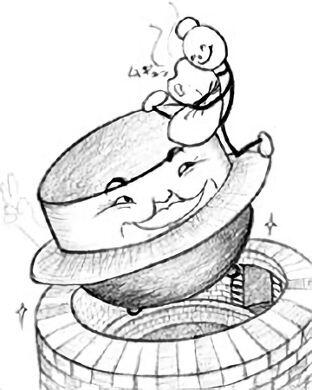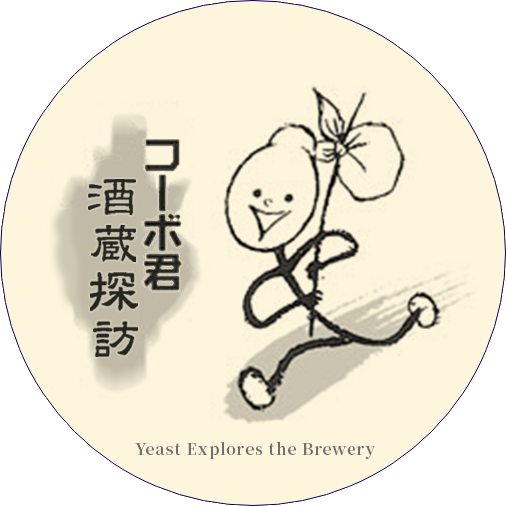| Yeast |
“Cauldron, I hear a new furnace has been installed. I’d like to have a look!” |
| - - A spic-and-span new furnace. Cauldrons have been installed at the two ranges constructed with firebricks. Outside stands a tall firebrick chimney. - - |
| Yeast |
“Congratulations, Cauldron. Very comfortable!” |
| Cauldron |
“Thank you, Yeast. It’s new, but isn’t there also something of a nostalgic feeling...” |
| Yeast |
“Really, it’s the same atmosphere as in the past. Today most breweries use automatic rice steamers. Why is Daishichi still using a furnace?” |
| Cauldron |
“Yes, we cauldrons have almost disappeared. Daishichi wanted to install a good new furnace while the craftsmen who can make that are still alive.” |
| Yeast |
“Yes, even when we want to have a furnace made in the future, there are perhaps no craftspeople left who can do it.” |
| Cauldron |
“And that while cast iron cauldrons are really best, for they boil the water with a strong fire and direct an ample amount of strong steam into the steam basket to steam the rice.” |
| Yeast |
“It’s as if the rice has been steamed in a pressure vessel, on the outside the rice is hard, but inside it’s elastic.” |
| Cauldron |
“Because the cast iron cauldron gets burning hot through the fire, the steam is once again heated while it rises up from the cauldron, and it becomes super-heated dry steam of more than a 100 degrees. I’m really proud of that!” |
| Yeast |
“It’s not at all like the simple system where steam from a boiler is blown over the rice while it passes through the machine on a belt conveyor. Our steamed rice is not at all watery, and so dry it doesn’t stick to your hands. When you grasp it in your hand, you feel its elasticity. Such a feat is indeed only possible with a cast iron cauldron and a steam basket.” |
| Cauldron |
“You have studied it really well. The master brewer of Daishichi considers the steaming of the rice as so important that he says: ‘The most important thing is steaming, the second most important thing is steaming and the third most important thing is also steaming.’ Just any way of steaming will not do.” |
| Yeast |
“When the rice has been steamed well, the brewers are all feeling bright and happy, but when they have to work with watery, soft steamed rice they feel troubled.” |
| Cauldron |
“Therefore it’s always a serious struggle to decide the best pattern that fits the character of the rice of a particular year. How much moisture it should be allowed to contain, and how long it should be steamed.” |
|
 |
| Yeast |
“That’s hard work. By the way, when is the rice steamed after it has been polished?” |
| Cauldron |
“The rice is not steamed all at the same time. For one batch of sake, steamed rice is necessary in a number of stages. We have the rice used in the yeast starter, both as koji and as steamed rice, and then in the same way the rice for the first filling of the fermentation tank, the rice for the second filling and the rice for the third filling. So spread out over one month, eight batches of rice are needed, and these are steamed just before they are used, according to the schedule of the brewery. The first time only a small amount is needed, but the volume gradually increases.” |
| Yeast |
“I’m getting confused!” |
| Cauldron |
“I should think so. On top of that several batches of rice are steamed at the same time, divided in separate textile bags.” |
| Yeast |
“Is that why Daishichi only uses a limited number of different rice brands?” |
| Cauldron |
“Yes, for when you use a number of different types of rice, it is difficult to determine the best way of steaming – after all you are steaming different types of rice together. That won’t result in good steamed rice. That’s why Daishichi only uses Yamada Nishiki and Gohyakumangoku sake rice.” |
| Yeast |
“Only two kinds? There are so many new kinds of sake rice available. Have you never thought of using more varieties of rice?” |
| Cauldron |
“Yeast, ‘if you run after two hares, you will catch neither.’ I know both Yamada Nishiki and Gohyakumangoku very well, these are two dependable types of rice. If you give me a few days or even hours, I can soon determine what the rice of a certain year is like, and then achieve the same quality of steamed rice as in other years.” |
| Yeast |
“You’re splendid!” |
| Cauldron |
“I only dedicate myself to making the best steamed rice. The rest I leave to the brewers!” |
| Yeast |
“Thanks, and keep it up.” |





